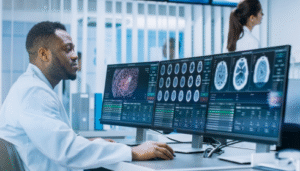
In today’s fast-paced, technology-driven world, healthcare is constantly evolving to meet the growing needs of patients and medical professionals. One of the most impactful advancements in this field is teleradiology services. Teleradiology has significantly transformed how diagnostic imaging is interpreted, shared, and utilized, offering timely and accurate results to improve patient outcomes. This article delves into the importance, benefits, and working mechanisms of teleradiology, shedding light on why it is becoming an essential part of modern medical practice.
What is Teleradiology?
Teleradiology is the transmission of radiological images such as X-rays, CT scans, MRIs, and ultrasounds from one location to another for the purpose of sharing studies with other radiologists and physicians. This process enables radiologists to provide services without being physically present where the imaging is performed. Teleradiology bridges the gap between healthcare providers and patients, especially in remote or underserved areas where specialized radiology services may not be readily available.
How Teleradiology Services Work
Teleradiology operates through a seamless integration of imaging equipment, Picture Archiving and Communication Systems (PACS), and secure internet connections. Once an imaging scan is completed, the images are digitized and securely transmitted to radiologists who can review them in real-time or within a scheduled reporting window. These specialists can then provide detailed diagnostic reports back to the referring physicians almost instantly, expediting treatment decisions and improving patient care.
Benefits of Teleradiology Services
The adoption of teleradiology services offers a multitude of benefits for healthcare providers, patients, and radiology specialists:
-
Enhanced Accessibility: Teleradiology extends radiology services to rural and remote locations where access to experienced radiologists is limited.
-
Faster Turnaround Time: Since radiologists can work from various locations and across different time zones, reporting can be provided on a 24/7 basis, ensuring faster diagnosis and treatment.
-
Specialized Expertise: Hospitals can consult subspecialty radiologists who are experts in specific areas such as neuroradiology, musculoskeletal imaging, or pediatric radiology, which may not be available locally.
-
Cost Efficiency: By reducing the need for on-site radiologists during off-hours and lowering operational costs, teleradiology provides significant financial advantages to healthcare facilities.
-
Improved Patient Care: Quicker access to diagnostic reports allows physicians to make timely, informed decisions, which is crucial for emergency cases and critical care.
Applications of Teleradiology
Teleradiology services are extensively used in several areas of healthcare, including:
-
Emergency Radiology: Immediate interpretation of trauma and emergency cases, which is crucial for life-saving interventions.
-
Nighttime Radiology (Nighthawk Services): Off-hour coverage provided by radiologists in different time zones to ensure 24/7 service availability.
-
Subspecialty Reporting: Access to highly specialized radiologists for complex or rare cases.
-
Rural and Remote Healthcare Support: Delivering high-quality radiology services to regions where there is a shortage of medical experts.
Challenges in Teleradiology
While teleradiology offers numerous advantages, there are certain challenges that must be managed to ensure its effectiveness. These include maintaining strict patient data confidentiality, adhering to legal and regulatory standards across different regions, ensuring seamless system integration, and managing the potential for communication gaps between radiologists and on-site physicians.
The Future of Teleradiology
The future of teleradiology services looks promising with the continued advancement of technologies like artificial intelligence (AI), machine learning, and cloud-based storage solutions. AI is expected to assist radiologists by automating preliminary reads and detecting anomalies with high accuracy, further speeding up the diagnostic process. Additionally, improved telecommunication infrastructure will enhance image transmission speeds and reporting capabilities.
Conclusion
Teleradiology services have become an indispensable component of modern healthcare, offering rapid, efficient, and expert imaging solutions that bridge geographical gaps and improve patient care. By leveraging the power of technology, teleradiology not only expands the reach of radiology services but also plays a critical role in emergency response, cost management, and quality healthcare delivery.



